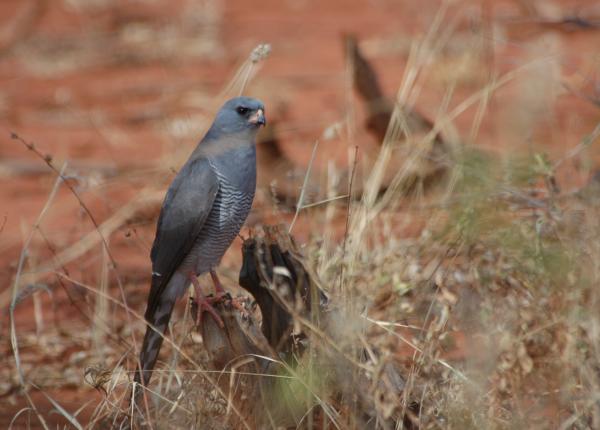Did You Know?
- Scientists recognize three subspecies of the Gabar Goshawk
- The Gabar Goshawk has been documented hunting in concert with a Red-necked Falcon.
- These hawks will place webs of live colonial spiders on their nests. The spiders continue to expand their web over the hawk nest by the time the nestlings have fledged. They do this probably as way to help them camouflage their nest.
How The Peregrine Fund is Helping
Though The Peregrine Fund doesn't work directly with Gabar Goshawk, in Kenya, our scientists are working hard to learn about and protect all raptors and their habitats. Through environmental education efforts, we are also working to put a stop to the common practice of poisoning carcasses to kill large predators, which also kills a host of wildlife including vultures, eagles, and other scavenging birds. These efforts will certainly benefit all raptors of the region, including the African Goshawk.
Meanwhile, our efforts in scientific research, habitat conservation, education, and community development help conserve birds of prey around the world. We also supply literature to researchers from our avian research library, which helps scientists around the world gather and share important information on raptor conservation. We also run the Global Raptor Impact Network which gives raptor researchers tools to more efficiently conduct their own studies while contributing to a global program. GRIN also provides citizen scientists a way to participate in raptor science and conservation.
Where They Live
The Gabar Goshawk is widespread throughout much of sub-Saharan Africa. From savannas, to open woodlands, thornbushs, steppe habitats, agricultural fields, and riparian areas, this species can be seen flying, hunting and perching in a wide variety of habitats throughout its range. However, it does avoid thick forests or extremely arid landscapes. Researchers have noted that, in relatively recent years, this hawk has started colonizing urban areas in some parts of its range. It usually spends most of its time alone, or in pairs. It spends a lot of time sitting in well-concealed perches high up in trees.
Why They Need our Help
The Gabar Goshawk is categorized as a species of Least Concern, probably because the species is widespread and common throughout open habitats of most of sub-Saharan Africa. The spread of Acacia-type habitats in some former grassland areas has probably extended the range of this species. Categorized globally as a species of "Least Concern" by BirdLife International.
What They Eat
The Gabar Goshawk consumes many different types of prey, but it seems to prefer hunting birds of all different sizes. It will even feed on eggs and nestlings of other bird species, particularly those of weavers.While most of the birds it takes are about the size of a sparrow or a bit larger, researchers have documented them feeding on Crested Francolin - which can weigh up to 238 g, young Helmeted Guineafowl. Apart from the long list of bird species it hunts, it will also feed on small mammals, including bats, reptiles, and insects.
When on the hunt, it often strikes its prey from a hidden perch, or chases its prey into bushes.It is known to hunt in pairs sometimes, as well. Researchers have observed that this species' hunting techniques are very accipiter-like.
Nests, Eggs, and Young
Gabar Goshawks build stick nests near the top of a thorny tree. The female will lay 2-4 eggs. She will do all of the incubation of the eggs and brooding of the newly hatched nestlings. The female does all of the incubation and brooding of her young offspring, while the male spends his time hunting and bringing food the female and the nestlings. After around 35 days or so, the nestlings will hatch They will grow quickly and after just another 35 days they will be ready to fly from the nest for the first time. Some individuals are melanistic, which means they are darker overall.
Gabar Goshawk and the World Center for Birds of Prey
The World Center for Birds of Prey offers fun ways to learn about birds of prey. Interactive activities, tours, interesting videos and a children's room with activities from coloring sheets to quizzes to costumes are all available for our guests. We also have knowledgeable, on-site staff to answer any questions you may have. Though we don't have any goshawks on our Avian Ambassador team, the Northern Goshawk can be found in Idaho year-round. They nest in large trees within the Sawtooth National Forest located only a few hours away from The Peregrine Fund's World Center for Birds of Prey.
References:
Global Raptor Information Network. 2021. Species account: Gabar Goshawk Micronisus gabar. Downloaded from http://www.globalraptors.org on 1 Sep. 2021
Kemp, A. C. and G. M. Kirwan (2020). Gabar Goshawk (Micronisus gabar), version 1.0. In Birds of the World (J. del Hoyo, A. Elliott, J. Sargatal, D. A. Christie, and E. de Juana, Editors). Cornell Lab of Ornithology, Ithaca, NY, USA. https://doi.org/10.2173/bow.gabgos2.01










